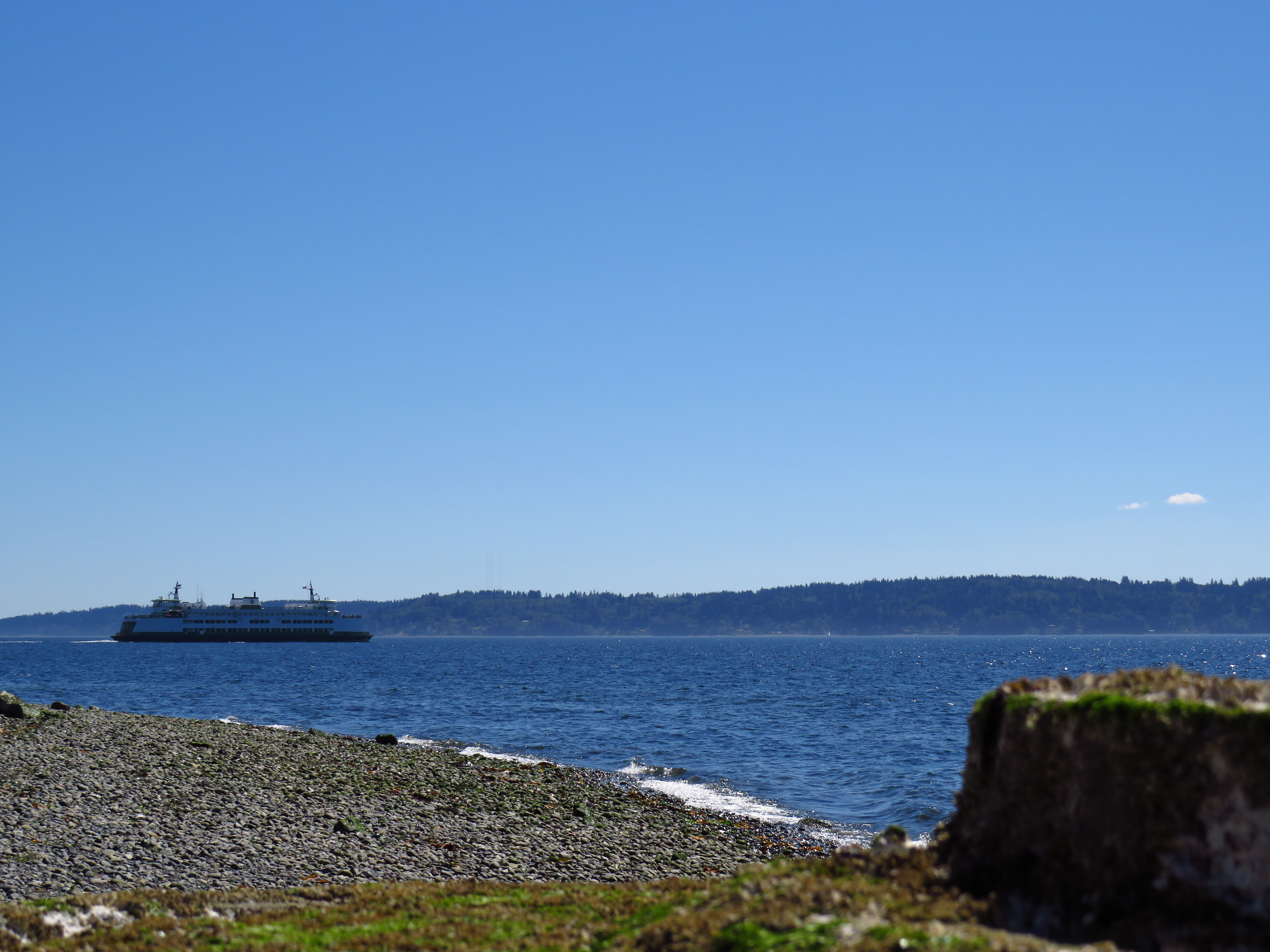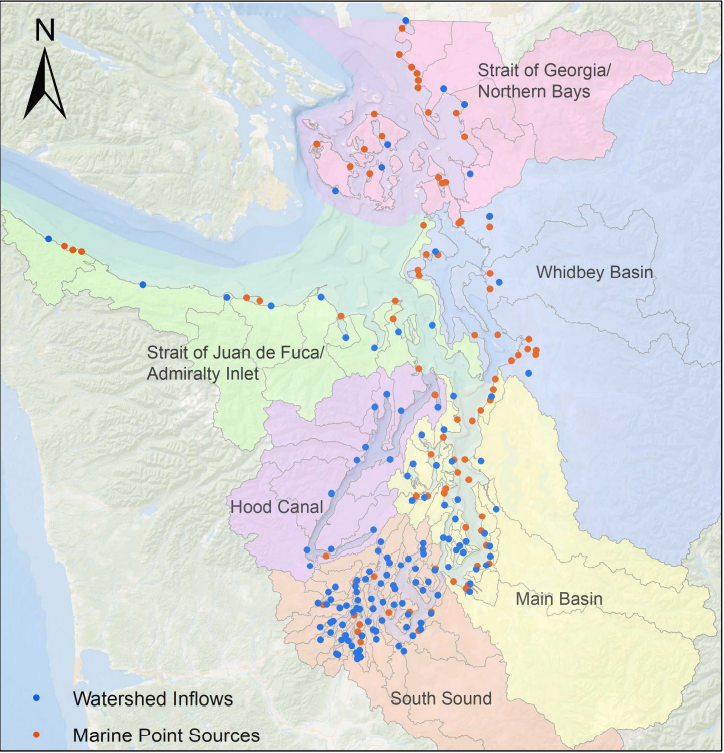Excess nutrients from humans are contributing to low oxygen levels in Puget Sound. This is bad news for aquatic life and means parts of Puget Sound do not meet water quality standards for dissolved oxygen. Just like humans, many organisms need oxygen to survive and dissolved oxygen standards are set at levels that protect healthy and robust communities of aquatic organisms. Our goal for the Puget Sound Nutrient Reduction Project is to reduce human nutrient sources so that dissolved oxygen levels meet water quality standards and support a healthy Puget Sound for orcas, salmon, shellfish and the many important marine organisms that call Puget Sound home.
This week, we shared our latest Salish Sea modeling results, which are moving us another step forward on regional efforts to reduce nutrients. The Salish Sea Model simulates water quality processes including how nutrients cycle and move around Puget Sound. Because we cannot measure and monitor every area of Puget Sound, modeling is an effective way to tease apart and evaluate the impact of different human nutrient sources. The Salish Sea Model is the best available tool we have to inform a strategy to improve dissolved oxygen in Puget Sound.
We are using modeling and monitoring to develop a science-based nutrient reduction plan focused on improving Puget Sound and meeting water quality standards. Developing a plan includes setting target reductions for nutrients and identifying actions required to achieve these targets.
Our most recent Salish Sea Modeling results predict that reducing nutrients from both wastewater treatment plants and watershed sources will significantly improve oxygen levels across Puget Sound.
You can read about these latest results in the Optimization Scenario Tech Memo and explore all modeling results in this interactive webmap.
Finding the right nutrient reduction mix
In the Spring of 2019, we met with the Nutrient Forum, a public stakeholder group focused on addressing nutrient pollution in Puget Sound, to develop a list of nutrient reduction “scenarios” that the Salish Sea Model could evaluate.
Our goals? To better understand the impact of human sources of nutrients and find a combination of nutrient reductions that will lead to improved oxygen levels. We want to meet marine water quality standards and support a healthier Puget Sound for years to come.
Salish Sea Modeling scenarios evaluated impacts of WWTPs
- Nutrient reductions at watersheds grouped by region
- Nutrient reductions at wastewater treatment plants (WWTP) grouped by region
- Applying annual vs. seasonal nutrient reduction technologies at WWTPs
- Increased WWTP flows in the future resulting from regional population growth
- Combining nutrient reductions from watersheds and WWTPs
We now have the results and analyses of all five scenarios. We encourage you to read the full results in Optimization Scenarios Tech Memo. For those of you looking for the highlights, here are some key takeaways from this round of modeling results:
Human sources of nutrients in watersheds contribute to low dissolved oxygen
We modeled how groups of watersheds and groups of wastewater treatment plants impact dissolved oxygen levels by turning on/off these nutrient sources by region. For example, we can evaluate the impact of nutrients from a region of Puget Sound by removing, or “turning off” the nutrient discharges from all wastewater treatment plants in one area (region), but keeping everything else the same. This allows us to evaluate the impact of that specific region across Puget Sound.
Model results predict that human sources of nutrients in watersheds contribute to low dissolved oxygen in the regions they discharge into, and for many regions like the deeper basins of Central Puget Sound, also contribute to lowering dissolved oxygen levels in other regions of Puget Sound.
Timing of treatment matters
We also evaluated the impact of reducing nutrients at domestic wastewater treatment plants discharging directly into or near Puget Sound. In scenarios where nutrients were reduced from these facilities on a year-round basis, versus seasonal reductions, the Salish Sea Model predicted greater improvements in dissolved oxygen levels and moved us closer to meeting water quality standards. This suggests that bigger reductions and/or reductions in fall and winter seasons are influential in improving dissolved oxygen.
Reductions from wastewater treatment plants alone, however, did not result in fully meeting water quality standards throughout Puget Sound. This tells us that we will need a combination of watershed and wastewater treatment plant reductions to meet our water quality goals.
If we don’t begin reducing nutrients now, water quality will get worse as our regional population grows
If we don’t take action to control nutrients, regional population growth will result in more nutrients entering Puget Sound. We evaluated the effect of future population growth on dissolved oxygen levels by estimating how wastewater treatment plant flows will increase based on future population growth estimates. We then looked at how these levels of nutrients will impact dissolved oxygen levels in Puget Sound. Not surprisingly, the model predicts that without nutrient controls, more humans will lead to more problems, meaning: expanded problem areas and more days of the year when dissolved oxygen levels do not meet water quality standards.
This future perspective highlights that now, more than ever, is the time for action to reduce human nutrient loads to protect Puget Sound from further decline.
The Puget Sound region is growing, which means nutrient will increase. If we do not act to reduce nutrients, modeling predicts that areas of low DO will only get worse as the population grows.
We need to reduce nutrients from all sources to meet standards
The Salish Sea Model predicts that a combination of reductions from human nutrient sources in watersheds and the wastewater treatment plants discharging directly to Puget Sound will result in the most improvement of dissolved oxygen levels and will move us closest to meeting dissolved oxygen standards. Significant reductions from wastewater treatment plants and watershed sources leads to big improvements across the Sound.
There are more combinations of nutrient reductions to evaluate!
The Optimization Scenarios Tech Memo is an interim analysis of results, which will help us build the knowledge to inform our next set of modeling scenarios. Continued modeling will help us understand how to get closer to meeting standards. In the next round of modeling, we plan to:
- Develop additional scenarios that involve more combinations of watershed and WWTP reductions.
- Develop combinations that include more localized reductions.
The full set of results and analysis of the scenarios from the Tech Memo, along with future modeling scenarios, will be published in a future report. We will use this report to help develop nutrient reduction targets that will be included in the Puget Sound Nutrient Reduction Plan and inform effluent limits in the Puget Sound Nutrient General Permit.
Upcoming Nutrient Forum meetings
If this work interests you, please join us at the Sept. 28 Puget Sound Nutrient Forum to discuss the results of the Tech Memo with Ecology’s modeling team. At a subsequent Forum, we will discuss a draft list of additional scenarios to test next.
For more information on upcoming Nutrient Forum meetings, please visit the Forum webpage.




